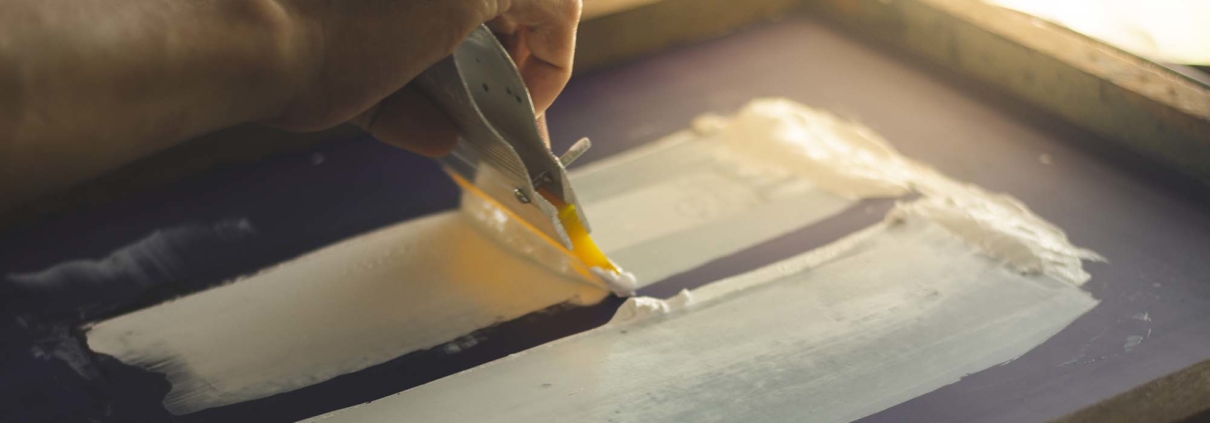
A thorough examination of the meaning of silk screen printing
A Silk Screen History Lesson
Today the term “screen printing” is often associated with digital printing, but it’s actually a form of fine art, especially when it pertains to silk. And when we say “silk screen,” we mean much more than just custom artwork, t-shirts, posters, and apparel. In this blog, we’ll walk you through the evolution of this screen printing technique and show you how it’s transformed into one of the most pivotal forms of personal expression.
The earliest discovery of screen printing is from China during the Song dynasty around 960 AD, when textile prints were found on different fabrics.
Early History
There’s no clear evidence of how the prints were made, but many experts believe that they were produced through a stencilling system. Fast forward to 1907, when Samuel Simon moved modern silk screen stencilling methods forward when he found new ways to print custom wallpaper (his patented processes later led to designs made using mesh fabric).
By 1911, silk screening officially became available for commercial use when John Pilsworth led a team of signwriters in producing custom clothboards. Each board was woven out of natural silk. In the 1930s, lettering grew in popularity, and by the 1940s, silk screening finally became a more common practice after chemist Colin Sharp developed the first photographic stencil.
The Mid-20th Century
The screen printing movement had a boom during the 1960s in the midst of the Civil Rights era. This societal revolution encouraged more media attention, and silk screen printing became a vital part of that media push and a way to spread the messages of the movement.
It wouldn’t take long for silk screen printing to become a primary form of artistic expression in the United States. The efficient custom printing method quickly took hold as a preferred contemporary art form and gained footing alongside traditional techniques such as painting and oil-based drawings. This rise in popularity is mainly attributed to legendary artist and screen printer Andy Warhol, who brought the art form to the forefront in 1962 with his iconic portrait of Marilyn Monroe in the first major silk screen diptych.
Whether you want to show off your pride for your favorite team or pop artist, a silk screen printed item gives you the perfect canvas to make your own statement.
The Modern Screen Printing Process
Warhol’s now-classic work helped start a movement in multiple fields, primarily in the advertising and entertainment industry. Think about those concerts or sporting events you go to. When you pass a vendor or walk through a gift shop, you’ll find silk screened logos printed on t-shirts or on a promotional item.
Today you’ll find more and more people taking the time to perfect this screen printing technique as it helps artists produce bold, colorful images faster than many other techniques. And don’t expect this trend to slow down any time soon, because the Environmental Protection Agency (EPA) is hard at work to help make this a safer process with less environmental impact.
Materials Needed
There are a number of supplies needed to create an effective screen print. In previous years, all you needed was a wooden frame, a blank canvas, and paint. But as time progressed, more unique printing technology processes evolved. To finalize a silk screen, you’ll need water-based inks, a squeegee, and glossy textures for that flawless finish.
Today, plenty of solutions are used to make the printing process more seamless and energy efficient. Today’s printing innovations are starting to revolve more around solar power as technology trends consist of electric, eco-friendly equipment. In the near future, expect to see more printing tools that use semiconducting materials such as screen-printed solar cells, solar photovoltaics, and solar wafers.
How the Print Is Applied
The silk screen printing process involves a mesh-covered frame, a transparent screen, and various stencil patterns. Patterns include shapes, letters, words, and images. Screen printers rest the screen above a canvas, such as a shirt or poster. The screen holds the material tightly, creating a firm texture for ink to create a proper outline of the stencil. Finally, you’ll use a squeegee to remove any excess substance to create a sharper image.
Unique Stenciling Techniques
The silk screening process has undergone many changes over time. A variety of stenciling methods have evolved throughout history, going back perhaps as far as ancient cave prints. Nowadays, many artists primarily demonstrate their creativity through aerosol graffiti. This micro-stenciling technique is used by artists and printmakers all over the world. It’s a simple method that requires only a mesh screen, proper lighting, and an airbrush. The artist rests the canvas directly under the light, placing the stenciling frame on top of the material, then gently sprays the ink to match the outline of the design. This method works flawlessly on any silk-like fabric.
Chicago’s Top Option for Silk Screening
When it comes to custom silk screening, there is no one better to work with than Marathon Sportswear. Our experts have mastered the art of screen printing. From concept to beyond completion, you can trust our team to help you pull off a stellar design on your unique canvas. We handle any size order and produce quality finished products with quick turnaround times.
We develop custom stencils and operate with the most sophisticated printing press machinery so that your logo always comes out right. Whether you need new t-shirts, other apparel, or promotional products, expect a design that meets your standards.
Reach out today to claim your quick quote!


